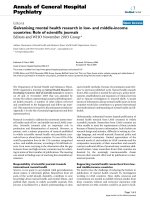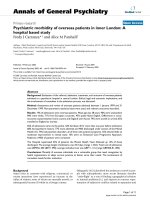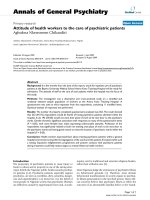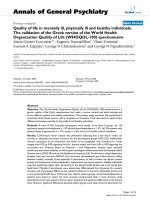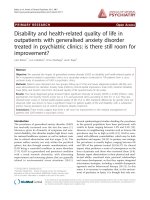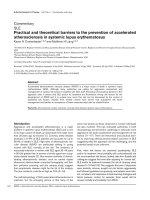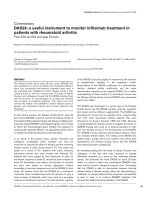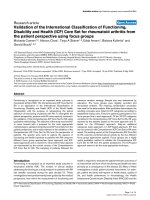Báo cáo y học: " Attitude of health workers to the care of psychiatric patients" potx
Bạn đang xem bản rút gọn của tài liệu. Xem và tải ngay bản đầy đủ của tài liệu tại đây (192.25 KB, 7 trang )
BioMed Central
Page 1 of 7
(page number not for citation purposes)
Annals of General Psychiatry
Open Access
Primary research
Attitude of health workers to the care of psychiatric patients
Aghukwa Nkereuwem Chikaodiri
Address: Department of Psychiatry, Aminu Kano Teaching Hospital, Kano, Nigeria
Email: Aghukwa Nkereuwem Chikaodiri -
Abstract
Background: In a few months from the time of this report, wards for inpatient care of psychiatric
patients at the Bayero University Medical School Aminu Kano Teaching Hospital will be ready for
admissions. The attitude of staff to the care of such patients within the hospital was the focus of
this study.
Methods: The investigation was a descriptive and cross-sectional study on a stratified and
randomly selected sample population of workers at the Aminu Kano Teaching Hospital. A
questionnaire was used to elicit responses from the respondents, containing 11 modified items.
Statistical analysis of responses was performed.
Results: The number of properly completed questionnaires analysed was 362. The result showed
that 232 (64.1%) respondents would be fearful of having psychiatric patients admitted within the
hospital. In all, 192 (53.0%) would not want their place of work to be next door to the psychiatric
wards. Gender showed a significant association with responses on many of the questionnaire items
(P < 0.05), with more females than males expressing unfavourable attitudes. Profession of the
respondents was significantly related to both not wanting ones place of work to be next door to
the psychiatric wards and having good reason to resist the location of psychiatric wards within the
hospital (P < 0.05).
Conclusion: Health workers expressed fears about treating psychiatric patients within a general
hospital environment and preferred segregation of the wards and the patients if treated within such
a setting. Expansive enlightenment programmes and positive contacts with psychiatric patients
during treatment could help reduce stigma to mental illness by health workers.
Introduction
The propensity of psychiatric patients to cause injury or
harm to others and to property is one of the strong stere-
otype beliefs the Nigerian public holds towards psychiat-
ric patients [1-4]. Psychiatric patients, especially vagrant
psychotics, are seen as worthless, dirty, senseless, danger-
ous and unpredictable [1,4]. Moreover, it is the belief of
most people in Nigerian society that psychiatric illnesses
are afflictions caused by supernatural forces and, as such,
require care by traditional and syncratic religious healers,
rather than orthodox care [3].
Most Nigerians judge the seriousness of psychiatric illness
on behavioural grounds [1]. Therefore, most deviant
behavioural manifestations in society equate to psychiat-
ric illness presentation in the involved person. Many Afri-
can societies believe that psychiatric illness is either the
outcome of an abominable familial defect or the 'handi-
Published: 23 August 2009
Annals of General Psychiatry 2009, 8:19 doi:10.1186/1744-859X-8-19
Received: 1 April 2009
Accepted: 23 August 2009
This article is available from: />© 2009 Chikaodiri; licensee BioMed Central Ltd.
This is an Open Access article distributed under the terms of the Creative Commons Attribution License ( />),
which permits unrestricted use, distribution, and reproduction in any medium, provided the original work is properly cited.
Annals of General Psychiatry 2009, 8:19 />Page 2 of 7
(page number not for citation purposes)
work of evil machinations' (demons, evil spirits). There-
fore, these negative beliefs result in psychiatric patients
being seen as outcasts and people that should be quaran-
tined [3].
The psychiatric patient, in the minds of the Nigerian pub-
lic, is responsible for their illness, especially when it is an
alcohol and/or substance-related problem. This belief
denies them the sympathy and understanding tradition-
ally bestowed on the sick in African society [3,4].
Misunderstanding of psychiatric illnesses by the public as
outlined above robs the psychiatric patient of, among
other things, provision of satisfactory mental and physical
healthcare services, even in the tradocultural context. Gen-
erally, misconceptions about psychiatric patients being
under the control of evil spirits (and therefore being dan-
gerous) are the main motivations behind the inglorious,
long and persistent use of physical restraints and endors-
ing of segregating attitudes by society towards them [5].
Health workers are not completely free from these above-
mentioned unfavourable beliefs and attitudes towards
psychiatric patients [3,5,6].
The present study, which determined health workers
opinions about caring for psychiatric patients within a
general hospital setting, took place in Aminu Kano Teach-
ing Hospital, Kano, Nigeria. The Teaching Hospital, estab-
lished in 1988 for Bayero University Medical School, has
state of the art facilities. It is a fully functional, almost
1,000-bed hospital designed to cater for the health needs
of communities within the northwestern zone of the
country and beyond. In addition, teaching and research in
health-related matters are among the services undertaken
in the hospital.
Currently, there are 17 clinical departments offering
patient services and conducting training and research, as
well as over 10 support service departments. The psychia-
try department building is among new structural facilities
presently been erected within the hospital. Since the foun-
dation of the hospital, inpatient psychiatric services were
located at a facility 60 km from the hospital complex. On
completion of the new psychiatry department, inpatient
psychiatry care would commence within the hospital
complex.
The present study, while determining the attitudes of
health professionals to the care of psychiatric patients
within the hospital, also looked at possible relationships
between some of their attitudes to such care and their
sociodemographic characteristics. Findings from this
study may be a good guide when planning mental health
enlightenment programme goals that have hospital work-
ers as the target population.
Methods
The psychiatry department, within months of this report,
will have wards ready for admission of patients within the
hospital. The study therefore determined if the attitudes of
the health workers at Aminu Kano Teaching Hospital are
favourable towards the care of psychiatric patients within
the hospital. The study was descriptive and cross-sec-
tional, conducted between February and March 2009.
Samples for the study came from the staff population of
the Aminu Kano Teaching Hospital, grouped into nine
strata by profession. The sample size of 326 with a 95%
confidence interval and a 4.6% margin of error were taken
from a population of 1,211 health workers comprising:
253 doctors, 437 nurses, 28 pharmacists, 163 administra-
tors, 113 laboratory scientists, 17 social workers, 17 phys-
iotherapists, 82 medical records officers, and 103 hospital
support staff. Due to possible attritions, an additional
10% of the original sample size was added to give a work-
ing sample size of 363. The sample comprised 77 medical
doctors, 132 nurses, 8 pharmacists, 49 administrators, 34
laboratory scientists, 5 social workers, 6 physiotherapists,
25 medical records officers, and 31 support staff.
The instrument for the study was an 11-item modified
and pretested questionnaire, used in a previous commu-
nity survey on attitudes to mental illness [7]. Since the
study sample was from a Nigerian literate population, the
questions were in English.
The questionnaire was pretested on 10 conveniently
selected staff from the hospital, comprising 3 doctors, 1
medical laboratory scientist, 4 nurses, and 2 hospital
administrators. They commented on (1) their ability to
understand the questions, (2) what they felt the questions
wanted to find out, and (3) any questions they felt needed
clarifying, with suggestions on how this could be
achieved. There were minor revisions performed on the
questionnaire based on the responses from the pilot
study.
Focus group discussions on the 11 items in the question-
naire took place among the hospital workers, interdepart-
mentally at different times. The groups numbered
between five to eight members, comprising doctors,
nurses, administrators and support staff present at the
time of the discussion.
The participants, after going through the questions,
expressed their opinions on the topics, while the
researcher, who was also the group facilitator, listened
and noted their comments on each of the items.
The questions measured the anticipated fear and exclu-
sion intentions of the health workers towards psychiatric
Annals of General Psychiatry 2009, 8:19 />Page 3 of 7
(page number not for citation purposes)
patients. Questions asked in the interview focused on: (a)
demographic characteristics of the respondents such as
age, sex, department, profession, marital status, religion
and tribe; and (b) respondents' fear intentions and exclu-
sion reactions towards the admission of psychiatric
patients within the hospital.
Some of the statements discussed/questions asked were:
'locating psychiatric wards within the hospital premises
does not put other patients on admission in danger', 'it is
fearful to think of people with mental problems admitted
within the hospital premises', and 'psychiatric wards
should be placed outside the hospital premises'.
The respondents' either agreed or disagreed with the ques-
tions/statements. A positive or favourable response was
one that supports caring for psychiatric patients within
the hospital premises. Trainee psychiatrists helped to dis-
tribute the questionnaire interdepartmentally. Members
of staff in the chosen professions in each department, who
picked numbers by balloting, completed the question-
naire. The hospital's ethical committee granted consent to
conduct the survey before it commenced.
Data analysis
Data summary after analysing with the SPSS statistical
package (SPSS, Chicago, IL, USA) was with simple fre-
quency distribution tables. Tests of association between
some of the responses and some of the respondents' soci-
odemographic features such as type of profession, gender,
and sex were determined with the χ
2
test. A P value of ≤
0.05 was considered statistically significant.
Results
The number of analysed questionnaires that were prop-
erly completed was 362, representing 99.7% of the esti-
mated sample size for the study. The recipients comprised
77 (21.3%) doctors, 132 (36.5%) nurses, 8 (2.2%) phar-
macists, 49 (13.5%) administrators, 34 (9.4%) laboratory
scientists, and 5 (1.4%) social workers, 6 (1.7%) physio-
therapists, 31 (8.6%) support staff, and 20 (5.5%) records
officers.
Among these, 197 (54.4%) were males and 164 (45.3%)
were females; 239 (66.0%) were married, and 119
(32.9%) were single. Three (0.8%) of the respondents
were divorced and one (0.3%) was widowed.
The majority (289 (79.8%)) of the respondents were Mos-
lems and 72 (19.9%)) were Christians. The predominant
ethnic nationality of the recipients was Hausa (265
(73.2%)), 33 (9.1%) were Igbos, 30 (8.3%) Yorubas, and
34 (9.4%) were from various ethnic minority tribes in the
country. The mean age of the respondents was 33.2 ± 5.8,
range 20 to 58 years.
More than half (214 (59.1%)) of the respondents were of
the opinion that locating psychiatric wards within the
hospital premises would not put other patients on admis-
sion in danger. In the same manner, 198 (54.7%) of them
did not think it was reasonable for the hospital staff to
resist the location of psychiatric wards within the hospital.
However, 232 (64.1%) would feel fearful at the thought
of having people with mental problems admitted within
the hospital. A total of 200 (55.2%) respondents felt hos-
pital staff had nothing to fear from psychiatric patients
coming to receive treatment within the hospital.
About three in every five (61.0%) respondents' did not
think that having psychiatric patients on treatment within
the hospital was too great a risk to other people in the hos-
pital. In addition, 299 (82.6%) of the respondents did not
think locating psychiatric wards within the teaching hos-
pital would downgrade it.
More than half (192 (53.0%)) of the recipients would not
wish to have their place of work next door to the psychiat-
ric wards. Despite the above opinion, 222 (61.3%) did
not favour placing psychiatric wards outside the hospital
complex.
A total of 276 (76.2%) respondents agreed the location of
psychiatric wards should be in the hospital, to best serve
the needs of the community. In a similar manner, 239
(66.0%) of them felt nobody had the right to exclude psy-
chiatric wards from being a type of ward located within a
teaching hospital.
Many (240 (66.3%)) respondents preferred wards for the
admission of psychiatric patients to wards for admission
of immune depressed patients (that is, HIV patients).
There were significant associations between the gender of
the respondents, and their attitudes to caring for psychiat-
ric patients within the hospital premises. The female
respondents held more unfavourable attitudes on most of
the items assessing fear and exclusion intentions than the
male respondents did (Table 1).
More male (129 (65.5%)) recipients than females (84
(51.2%)) agreed to other patients not being in danger by
locating psychiatric wards within the hospital (χ
2
= 8.23,
degrees of freedom (df) = 2, P < 0.05). The female recipi-
ents were also more agreeable to resisting the location of
psychiatric wards within the hospital, and to such loca-
tion posing a great risk to others in the hospital.
The proportion of the female recipients who favoured
locating psychiatric wards outside the hospital premises
was more than that of the male recipients of the same
opinion. Likewise, the female recipients were less keen on
Annals of General Psychiatry 2009, 8:19 />Page 4 of 7
(page number not for citation purposes)
having their place of work next door to the psychiatric
wards.
A significant number of the male recipients agreed to
accepting the location of psychiatric wards within the hos-
pital than the female recipients, (Table 2).
More than three in every five of the hospital's nurses,
administrators and support staff significantly did not
favour having their place of work next door to the psychi-
atric wards. A little more than half of the doctors and more
than three in every five of the hospital's pharmacists,
social workers, physiotherapists, and medical records
officers would not mind having their place of work next
door to the psychiatric wards.
More than half of nurses, administrators, support staff,
and laboratory scientists favoured workers resisting the
location of psychiatric wards within the hospital
premises. An equal proportion of physiotherapists were
either in favour or against the above opinion. The major-
ity of doctors, pharmacists, social workers and medical
records officers that answered the questionnaire were not
in favour of the former opinion.
There was a significant relationship between the profes-
sion of the respondents and their attitude towards resist-
ing location of psychiatric wards within the hospital
premises, (Table 3). Age, marital status, religion, and tribe
of the respondents were not significantly related to their
attitude to the care of psychiatric patients within the hos-
pital (P > 0.05). A focus group discussion with some of the
hospital staff, revealed a repeating remark on the need to
have the psychiatry departmental building surrounded by
high walls, rather than leaving it 'open' like others.
Discussion
Findings from the survey showed that many hospital
workers, especially females, expressed anticipatory fears
towards letting psychiatric patients obtain admission for
treatment within a general hospital setting. This view was
very likely caused by many workers not wishing their
place of work to be close to the psychiatric wards. In addi-
tion, many nurses, administrators, hospital support staff
and laboratory scientists would support resisting provi-
sion of such an inpatient care facility inside the hospital.
Negative attributions towards psychiatric patients by
Nigerian health workers was claimed to be due to deeply
Table 1: Crosstabulation report between gender of respondents and their responses on some variables assessing perceived fear
towards psychiatric patients
Variable Male Female
Agree (%) Disagree (%) Agree (%) Disagree (%) χ
2
df P value
Not a danger to other patients 129 (65.5%) 68 (34.5%) 84 (51.2%) 80 (48.8%)
Good reason to resist location 73 (37.1%) 121 (61.4%) 88 (53.7%) 76 (46.3%) 12.6 4 0.01
Too great a risk to other people 61 (31.0%) 136 (69.0%) 79 (48.2%) 84 (51.2%) 13.4 4 0.01
Wards should be placed outside the hospital premises 64 (32.5%) 133 (67.5%) 76 (46.3%) 88 (53.7%) 7.88 2 0.02
Do not want my place of work to be next door to a psychiatric
ward
92 (46.7%) 103 (52.3%) 100 (61.0%) 64 (39.0%) 9.66 4 0.047
Accept location of psychiatric wards within hospital premises 166 (84.3%) 31 (15.7%) 109 (66.5%) 54 (32.9%) 16.5 4 0.00
P ≤ 0.05 is significant.
df = degrees of freedom.
Table 2: Crosstabulation report between profession of respondents and responses on 'not wanting place of work next door to
psychiatric wards' by the respondents
Profession Agree (%) Disagree (%) χ
2
df P value
Medical doctor 37 (48.1%) 40 (51.9%) 32.47 16 0.009
Nurse 74 (56.1%) 58 (43.9%)
Pharmacist 3 (37.5%) 5 (62.5%)
Administrator 30 (61.2%) 19 (38.8%)
Laboratory scientist 16 (47.1%) 16 (47.1%)
Social worker 2 (40.0%) 3 (60.0%)
Physiotherapist 2 (33.3%) 4 (66.7%)
Medical records officer 6 (30.0%) 14 (70.0%)
Support staff 22 (71.0%) 9 (29.0%)
P ≤ 0.05 is significant.
df = degrees of freedom.
Annals of General Psychiatry 2009, 8:19 />Page 5 of 7
(page number not for citation purposes)
rooted negative cultural beliefs and traditional acts that
result in a societal dislike for such patients [3]. A commu-
nity study on attitudes to mental illness in Nigeria showed
that more than half of the respondents' thought psychiat-
ric patients could not receive treatment from normal
health facilities [4]. This belief is due to the communities'
attribution of dangerousness to people with mental ill-
ness, because of occasional violent expressions by them. A
worrying implication of this negative understanding of
people with psychiatric illness is that communities could
meet propositions for the rendering of community based
mental healthcare with opposition [4].
A study in Kenya claimed that general health workers,
even if they were capable of handling psychiatric prob-
lems, preferred such patients to be managed by specialist
mental health institutions to having them managed in
general wards [8].
Some studies have claimed that stigmatising opinions
towards people with mental illness are common among
all classes of people in Europe and America [9-11]. These
expressed negative opinions towards consumers of men-
tal health services occurred despite the majority of the
respondents' understanding of biological and environ-
mental factors in the causation of mental illnesses. How-
ever, there were differences in the nature and extent of
stigma attached to the various psychiatric illnesses by
them [9,10].
Stigma, which signifies a mark to show that someone is of
a lesser value than others, abounds among health workers
in most cultures [12,13]. Society regards someone
labelled mentally ill with a stereotyped negative mindset,
and this leads to behaviours towards the sick person that
worsens his or her burden of illness. Prejudice towards
people with mental illness arises based on the societal
ignorance of such persons being dangerous and unpre-
dictable, less competent and unable to live productive
lives [12].
Because of the discriminatory behaviour portrayed by
societies towards people with mental illness, they tend to
become prejudiced towards themselves [14]. In the con-
text of most African societies, this internalised self-dislike
brings about denial of illness symptoms and refusal to
seek appropriate treatment on time. Both the mentally ill
and their relations then make a defensive attribution of
the sickness to the influence of supernatural forces, or the
handiwork of evildoers. In addition, the above defensive
attribution brings about the mentally ill and their rela-
tions' preference for solutions in the hands of religious
and traditional healers rather than going to hospital.
By the time, both the mentally ill person and his/her rela-
tions, who by courtesy and association share this stigma,
seek orthodox care, especially in the general hospital set-
ting, they face rejecting attitudes by the health workers.
This negative attitude by health workers leads to their ina-
bility to detect comorbid physical illnesses in psychiatric
patients. In cases where these are detected, the patients are
reluctantly and inappropriately cared for.
Stigma of mental illness remains high among health pro-
fessionals in general hospitals despite having 5% of
patients presenting at emergency departments with psy-
chiatric problems, and a high rate of medical and surgical
patients with psychological morbidity [15]. The absence
of synthesis in the minds of general hospital health pro-
fessionals about the mind not been separate from the
body, and that either could influence the other, was
claimed to be a significant contributory factor to their stig-
matising attitude to mental illness [16].
It is commendable that despite the health workers fear
intentions towards admitting psychiatric patients within
the hospital, there were remarkably favourable expres-
sions of attitudes for most of the variables assessing fear
and exclusion towards the same persons. The expectation
is that people working in health facilities should be more
humane towards the sick than others in society would be,
Table 3: Crosstabulation report between profession of respondents and responses on 'good reason to resist location of psychiatric
wards within the hospital premises' by the respondents
Profession Agree (%) Disagree (%) χ
2
df P value
Medical doctor 15 (19.5%) 62 (80.5%) 53.30 16 0.00
Nurse 70 (53.0%) 61 (46.2%)
Pharmacist 1 (12.5%) 7 (87.5%)
Administrator 28 (57.1%) 21 (42.1%)
Laboratory scientist 19 (55.9%) 13 (38.2%)
Social worker 1 (20.0% 4 (80.0%)
Physiotherapist 3 (50.0%) 3 (50.0%)
Medical records officer 5 (25.0%) 15 (75.0%)
Support staff 19 (61.3%) 12 (38.7%)
P ≤ 0.05 is significant.
df = degrees of freedom.
Annals of General Psychiatry 2009, 8:19 />Page 6 of 7
(page number not for citation purposes)
and most of the variables not overtly making the respond-
ents feel they would be in too close contact with psychiat-
ric patients may possibly have influenced the choice of
response. In addition, that three in every five workers
favoured not placing psychiatric wards outside the hospi-
tal is an indication of their expressed wish to have psychi-
atric patients treated within the premises, but in a manner
that would mean others around would feel protected
from their perceived risk of harm.
The finding that three in every five of the hospital nurses,
administrators, and support staff were more rejecting
towards having their place of work close to the psychiatric
wards might be due to their holding more inappropriate
information and deep rooted fears about the dangerous-
ness and unpredictability of such persons than others.
Psychiatric illness is universally equated with violence
[1,3,17], and as a result health workers, especially in gen-
eral hospitals, tend to favour segregation of psychiatric
patients, as was found in this study. This negative attribu-
tion especially by nurses towards psychiatric patients is
likely due to their experiences of aggression, mainly from
patients suffering paranoid schizophrenia, to their person
[18,19]. In addition, unconsciously stigmatising psychiat-
ric patients by health workers is a psychological compen-
satory justification for avoidance of someone who is
somehow different [3].
Generally, not all types of mental illness are associated
with violence, and further most psychiatric patients with
illnesses that have a risk of violence are not violent [20].
The risk of violence in a psychiatric patient increases with
the type of illness, use of alcohol and drugs, treatment
non-compliance, and to some extent lack of insight into
illness by the patient. Other factors include strange expe-
riences (such as command hallucinations and paranoid
beliefs of persecution), poverty, homelessness and a his-
tory of violence and criminality.
People with psychiatric illness are more likely to be the
victims, rather than the perpetrators, of violence [17].
Most crimes committed are in no way related to mental
illness, but there abound instances of sexual violations on
female psychotic vagrants, abuse of vagrants for money
making and other rituals, repeated verbal and physical
assaults, and unfortunately the death of some vagrants at
the hands of members of society. Most of these inhuman
experiences are due to societal prejudice and inappropri-
ate aggressive responses towards psychiatric patients.
Violent behaviours by psychiatric patients are most often
towards family relations, caregivers and friends rather
than strangers. Unfortunately there is no data known for
Nigeria on 'population attributable risk percentage' (PAR
%) that would have highlighted the percentage of vio-
lence attributable to psychiatric illness.
This study showed that more than 60% of the respondents
preferred having wards for the treatment of psychiatric
patients to those for immune-depressed patients. The
public's erroneous beliefs about HIV transmission [21] is
a possible explanation for the above finding.
Findings from this study would need repetition in other
similar hospitals before generalisation. Some of the hos-
pital health workers could have given responses that are
reflective of their status and not actually their true dispo-
sition to mental illness.
There is the need for proper harnessing of radio, television
and newspapers, which are important sources of informa-
tion to the public, for dissemination of messages that
would help to reduce stigma of mental illness. Psychiatric
staff in general hospitals should work towards challenging
the portrayal of stigma against their patients by other
healthcare providers within and outside the hospitals in
which they work. The psychiatric units should be skilled
in the proper management of patients that appear violent,
to abate situations that might heighten fears in the minds
of other members of the hospital community. Mental
health services should be properly funded by institutions,
government, and policy makers.
In conclusion, although psychiatric patients can be aggres-
sive under some situations, the amount of violence attrib-
utable to this scenario is very small. Enlightenment
programmes and encouraging friendly interactions with
recovering psychiatric patients by healthcare providers are
positive approaches towards reducing their prejudices
toward psychiatric patients.
Competing interests
The author declares that they have no competing interests.
References
1. Binitie A: Attitude of educated Nigerians to mental illness.
Acta Psychiatrica Scandinavica 1970, 46:27-46.
2. Awaritefe A, Ebie JC: Contemporary attitudes to mental illness
in Nigeria. African J Psychiatry 1975, 1:37-43.
3. Ewhrudjakpor C: Knowledge, beliefs and attitudes of health
care providers towards the mentally ill in Delta State,
Nigeria. Ethno Med 2009, 3:19-25.
4. Gureje O, Lasebikan V, Oluwanuga OE, Olley BO, Kola L: Commu-
nity study of knowledge and attitude to mental illness in
Nigeria. Br J Psychiatry 2005, 186:436-441.
5. Minas H, Diatri H: Pasung: physical restraint and confinement
of the mentally ill in the community. Int J Mental Health Syst
2008, 2:8.
6. Odejide AO, Olatawura MO: A survey of community attitudes
to the concepts and treatment of mental illness in Ibadan,
Nigeria. Nigerian Med J 1979, 9:343-347.
7. Wolf G, Soumtra P, Craig T, Leff J: Community attitudes to men-
tal illness. Br J Psychiatry 1996, 168:183-190.
Publish with BioMed Central and every
scientist can read your work free of charge
"BioMed Central will be the most significant development for
disseminating the results of biomedical research in our lifetime."
Sir Paul Nurse, Cancer Research UK
Your research papers will be:
available free of charge to the entire biomedical community
peer reviewed and published immediately upon acceptance
cited in PubMed and archived on PubMed Central
yours — you keep the copyright
Submit your manuscript here:
/>BioMedcentral
Annals of General Psychiatry 2009, 8:19 />Page 7 of 7
(page number not for citation purposes)
8. Muga FA, Jenkins R: Training, attitude and practice of district
health workers in Kenya. Soc Psychiatry Psychiatr Epidemiol 2008,
43:477-482.
9. Crisp AH, Gelder MG, Rix S, Meltzer HI, Rowlands OJ: Stigmatisa-
tion of people with mental illness. Br J Psychiatry 2000, 177:4-7.
10. Thiru GS, Yad MJ: Are mental health professionals immune to
stigmatizing beliefs? Psychiatr Serv 2005, 56:610.
11. Salter M, Byrne P: The stigma of mental illness: how you can
use the media to reduce it. Psychiatr Bull 2000, 24:281-283.
12. Sherman P: Stigma, mental illness, and culture. [http://
www.scribd.com/doc/11731670/The-Stigma-of-mental-Illness].
13. Shepherd S: They're possessed? Cultural views of mental ill-
ness. [ />sessed.html?hec=].
14. Larson JE, Corrigan P: The stigma of families with mental ill-
ness. Acad Psychiatry 2008, 32:87-91.
15. Bolton J: Reducing the stigma of mental illness. Student BMJ
2003, 11:87-130.
16. Tipper R, Mountain D, Lorimer S, Mclntosh A: Support workers'
attitudes to mental illness: implications for reducing stigma.
Psychiatr Bull 2006, 30:179-181.
17. Florez AJ, Holley HL, Crisanti A: Mental illness and violence:
proof or stereotype? Ottawa, Canada: National Clearing House on
Family Violence, Public Health Agency of Canada; 1996.
18. Jegede AS: The notion of "were" in Yoruba conception of
mental illness. Nordic J African Stud 2005, 3:5-9.
19. Jegede RO: A study of the role of socio-cultural factors in the
treatment of mental illness in Nigeria. Soc Sci Med 1981,
15A:49-54.
20. Walsh E, Buchanan A, Fahy T: Violence and schizophrenia:
examining the evidence. Br J Psychiatry 2002, 180:490-495.
21. Hustig A: Stigma of mental illness and HIV: causes and strat-
egies. [ />mental-illness-hiv-causes-strategies/].
